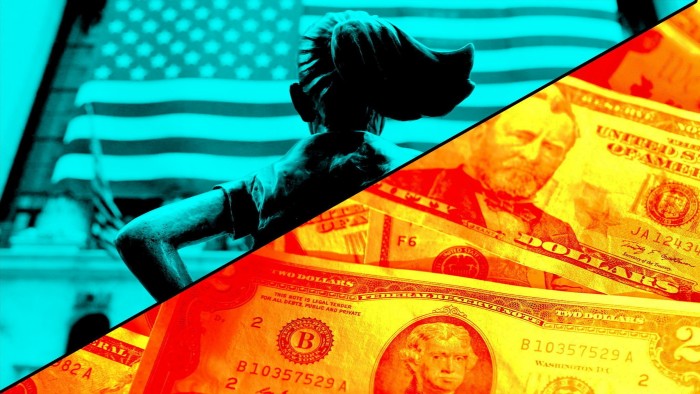Double or quits: valuing Wall Street (part 2)


Roula Khalaf, Editor of the FT, selects her favourite stories in this weekly newsletter.
For readers who understandably chose the Tour de France, Wimbledon or Tapioca Pudding Day over my investment ramblings last weekend, I wrote about US equities and whether to own loads more of them.
Don’t worry, I hadn’t reached a conclusion. Rather we ended on a dilemma. US firms are incredible at generating long-run returns but two valuation ratios — Cape and Q — suggest the S&P 500 is twice as high as it should be.
So should I dive in or wait? One reason to ignore these indicators is they have flashed red since the financial crisis. You would have missed a 300 per cent rise. Therefore, the question to ask is will they prove prescient in the end or has something fundamentally changed?
History is unequivocal. Valuation metrics based on cyclically-adjusted earnings or asset replacement costs have a solid — if not spectacular — record of spotting when US shares are too cheap or expensive. In the long run, they have predictive power.
Not any more, according to many professional money managers. Modern companies have changed so much, they argue, that the two methodologies are now significantly understating equity values. Is this true?
Let’s begin with Cape, although some of the issues we will address also affect Q (after all, assets are a function of retained earnings). What is Cape? Which valuation riddles does it solve or fail to grasp? Why does Batman wear one?
Company profits are volatile — in the short run because of one-offs and in the medium term due to cyclicality. Thus a standard price-earnings multiple, which uses just one year of earnings in its denominator, risks being anomalous.
Hence the economist Robert Shiller thought it more sensible to average 10 years’ worth of earnings. Not a bad idea — and cyclically-adjusted price-earnings ratios do have a better record of predicting future returns than the common version.
Naturally it has the same flaws as any earnings-based metric. Earnings are malleable, subject to accounting vagaries and have only a distant link to shareholder value. Intangibles also muddy the water, which I return to below.
Cape has two extra failings — seemingly big ones. It does not consider that companies change, nor that they tend to grow. Giving all 10 years of historic earnings the same weighting in the average makes no sense, therefore.
It is apples and pears to compare the price of the S&P 500 today with profitability a decade ago — worse if you consider the index level also reflects future earnings. In 2013, aggregate net profits were $130 per share. Last year they were $170.
In particular, megacap tech stocks grew like crazy over the past 10 years. Google’s annual bottom line has gone from $10bn to $60bn and yet Cape considers them equal in its calculation. Tesla didn’t even make a profit in 2013.
Likewise, companies morph. Amazon now has clouds, Microsoft went subscription and Facebook is betting on the metaverse. These changes are discounted in current share prices, so again it is weird to divide them by ages-ago earnings.
This is problematic in theory, but less so in practice. If we decrease the historic weights in the Cape denominator in a linear way such that earnings a decade back are half as important as current earnings, Cape only declines by about one point. It remains 30 times!
Still, tech companies highlight a bigger issue some investors have with earnings-based measures such as Cape. And that is they understate value because accounting rules treat internal spending on the likes of research and development, trademarks or copyright, as upfront costs.
If these were considered investments instead, amortised as intangible assets over a number of years, today’s earnings would leap like Nureyev — making equities more attractive.
Companies would not benefit equally. Amazon’s valuation multiple would roughly halve. But industries laden with physical assets are less affected. Overall, analysts estimate S&P earnings would rise between 10-20 per cent.
Not enough to bring Cape’s 50 per cent overvaluation back into line, though. Personally I don’t believe expenses such as R&D should be treated as investments. Most are stay-in-business costs, often wasted, and for the market as a whole a zero-sum game.
If you disagree, you must think valuation indicators based on net assets — such as Q or book value ratios — are also wrong. These exclude (self-made) goodwill too, which is the difference between the price of a company’s tangible assets and its market value.
When companies take each other over, goodwill does appear on balance sheets however. Thus we would expect to see the S&P 500 trading above the aggregate value of its tangible assets. But how much more again comes down to whether you reckon the likes of R&D should be expensed or capitalised.
Support for those in the latter camp links back to the profit and loss account, as it should. Because the level of an equity index (or stock) reflects historic earnings, and we know share prices trade above their book values, then earnings must routinely be understated — the logic goes.
The conclusion being that capitalising expenses would result in the same downward adjustment to Q as for Cape. But even lowering both by a fifth still leaves them screaming “SELL”. So is that it, then?
Almost. There is one credible reason left why these ratios may be warning prematurely: a possible surge in productivity — due to advances in AI, perhaps — which lifts aggregate earnings so far that Cape and Q ratios drop to their historical mean.
I’m bullish on productivity, as I’ve written. But not that bullish. So having begun this exercise hoping to double my US equity exposure, I’ve talked myself into quitting. Gosh.
The author is a former portfolio manager. Email: stuart.kirk@ft.com; Twitter: @stuartkirk__
Comments